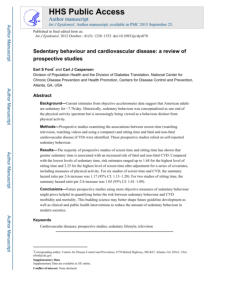Scientific papers 2011 - 2012

Classical decompression algorithms limit hypothetical
tissue gas contents and prescribe decompression
schedules with most of the total stop time (TST) allocated
to shallow decompression stops.
More recent bubble-model-based algorithms limit
hypothetical bubble profusion and size and prescribe
decompressions with TST skewed toward deeper stops.
This paper describes a man-trial that was organized to
compare the efficiency of these approaches.
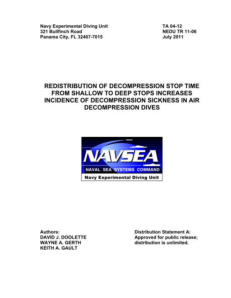

The Thalmann Algorithm parameterized with VVal-18 or
VVal-18M underlies U.S. Navy air and nitrox
decompression procedures.VVal-18 and VVal-18M air no-
stop limits at many depths are longer than the
corresponding no-stop limits in the 1957 standard air
decompression table that appeared in the U.S. Navy
Diving Manual from 1959 until it was replaced in Revision
6 (2008). However, the severity of DCS observed in man-
trials of the longer no-stop limits was unacceptable, and
consequently, in the Revision 6 air decompression tables,
the 1957 air no-stop limits were arbitrarily retained in
place of any longer VVal-18M-prescribed limits.
This report describes VVal-79, a modification of the VVal-
18M parameter set that enables the use of the Thalmann
algorithm to prescribe air diving no-stop limits and
decompression obligations that can be used as it is, with
no need for arbitrary edits to individual schedules.
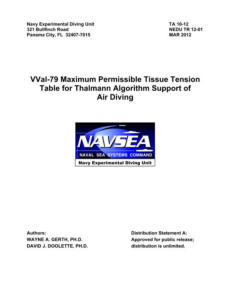

Authors:
Jasna Marinovic, Marko Ljubkovic, Toni Breskovic, Grgo
Gunjaca, Ante Obad, Darko Modun, Nada Bilopavlovic,
Dimitrios Tsikas, Zeljko Dujic.
The aim of this study was to evaluate the changes in
vascular/endothelial function following SCUBA diving
and to assess the potential difference between two
breathing gases: air and nitrox 36 (36% oxygen and 64%
nitrogen).
Ten divers performed two 3-day diving series (no-
decompression dive to 18 m with 47 min bottom time
with air and nitrox, respectively), with 2 weeks pause in
between. Arterial/endothelial function was assessed
using SphygmoCor and X ow-mediated dilation
measurements, and the concentration of nitrite before
and after diving was determined in venous blood.
Production of nitrogen bubbles post-dive was assessed by
ultrasonic determination of venous gas bubble grade.
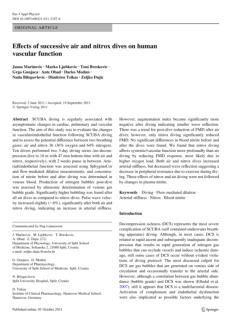

Authors:
Megan Brenner, Deborah Stein, Peter Hu, MS, Joseph
Kufera, MA; Matthew Wooford, Thomas Scalea.
The objective of this paper is to investigate the relationship
between oxygenation and short-term outcomes in
patients with traumatic brain injury (TBI).
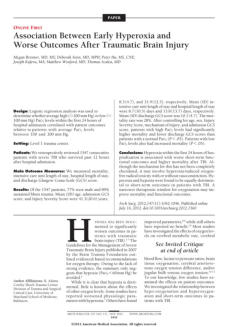

Authors:
M. Rozloznik, W. Hemelryck, F. Tilmanns, V. Papadopoulou
S. Theunissen, & C. Balestra.
The authors of this study focused on the effect of pre-dive
hydration after various preconditioning methods on
decompression stress in divers. To do so, various
anthropological, biochemical, and physiological
parameters were collected before and after a single dive
to 34m for 20 min divers undergoing no preconditioning
(n=10) or pre-dive preconditioning on vibration mat (n=8)
or in the sauna (n=7). The hydration level was assessed by
specific urine gravity multi-frequency bioelectrical
impedance analysis and was correlated to a number of
venous gas bubbles as measured by transthoracic
echocardiography 35 and 90 minutes after the dive.
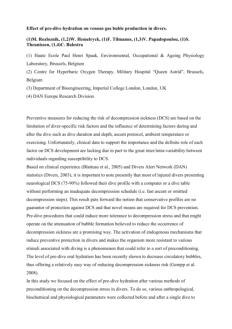

Authors:
A. Møllerløkken, S. E. Gaustad, M. B. Havnes, C. R. Gutvik,
A. Hjelde, U. Wisløff, A. O. Brubakk.
In recent studies, the authors have determined the impact
of VGE on endothelial function in both laboratory animals
and humans. They observed that the damage to the
endothelium due to venous gas emboli (VGE) was dose-
dependent and that the amount of VGE can be affected
both by aerobic exercise and exogenous nitric oxide (NO)
intervention before a dive. We observed that NO reduced
VGE during decompression and pharmacological
blocking of NO production increased VGE formation
following a dive.
The importance of micro-nuclei for the formation of VGE
and how it can be possible to manipulate the formation
of VGE are discussed together with the effects of VGE on
the organism. In the last part of the review, the authors
introduce their thoughts for the future and how the
enigma of DCS should be approached.
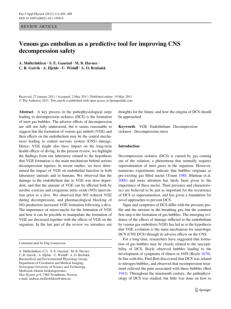

Authors:
Nicolas Vallee, Cédric Meckler, Jean-Jacques Risso, and
Jean-Eric Blatteau.
Nitrogen supersaturation and bubble formation can
occur in the vascular system after diving, leading to death
and nervous disorders from decompression sickness
(DCS). Bubbles alter the vascular endothelium, activate
platelets, and lead to focal ischemia with neurological
damage mediated by the mechanosensitive TREK-1
neuronal potassium ion channel that sets pre-and
postsynaptic resting membrane potentials. The authors
report a neuroprotective effect associated with TREK-1.
Mice were subjected to decompression from a simulated
90 msw dive. Of 143 mice that were wild type (WT) for
TREK-1, 51.7% showed no DCS, 27.3% failed a grip test,
and 21.0% died. Of 88 TREK-1 knockouts (KO), 26.1%
showed no DCS, 42.0% failed a grip test, and 31.8% died.
Mice that did not express TREK-1 had lower DCS
resistance and were more likely to develop neurological
symptoms. We conclude that the TREK-1 potassium
channel was neuroprotective for DCS.
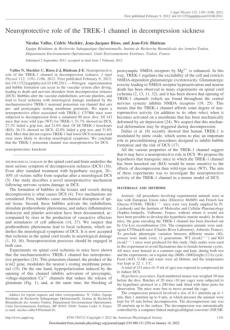

Authors:
Emmanuel Gempp, Jean Morin, Pierre Louge, and Jean
Eric Blatteau.
A low-grade process of coagulation activation in
association with severe neurological decompression
sickness (DCS) in divers has been anecdotally observed.
The authors aimed to investigate whether measurement
of plasma D-dimers and other hemostatic parameters in
injured scuba divers were effective as prognostic
biomarkers of neurological DCS, and they compared the
diagnostic accuracy of a combination of D-dimers test and
initial clinical assessment with either one alone.
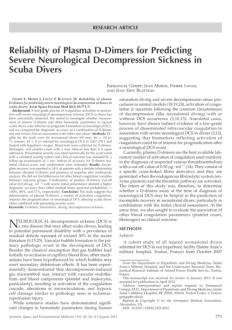

Authors:
Jean-Eric Blatteau, Sandrine Barre, Aurelie Pascual, Olivier
Castagna, Jacques H. Abraini, Jean-Jacques Risso, &
Nicolas Vallee.
Massive bubble formation after diving can lead to
decompression sickness (DCS) that can result in central
nervous system disorders or even death. Bubbles alter the
vascular endothelium and activate blood cells and
inflammatory pathways, leading to a systemic
pathophysiological process that promotes ischemic
damage. Fluoxetine, a well-known antidepressant, is
recognized as having anti-inflammatory properties at the
systemic level, as well as in the setting of cerebral
ischemia. The authors report a beneficial clinical effect
associated with fluoxetine in experimental DCS. Ninety-
one mice were subjected to a simulated dive at 90 msw
for 45 min before rapid decompression.


Authors:
Taiki Miyazawa, Masahiro Horiuchi, Daisuke Ichikawa,
Andrew W. Subudhi, Jun Sugawara, & Shigehiko Ogoh.
Facial cooling (FC) increases cerebral blood flow (CBF) at
rest and during exercise; however, the mechanism of this
response remains unclear. The purpose of the present
study was to test the author's hypothesis that FC causes
facial vasoconstriction that diverts skin blood flow
(SkBFface) toward the middle cerebral artery (MCA
Vmean) at rest and to a greater extent during exercise.
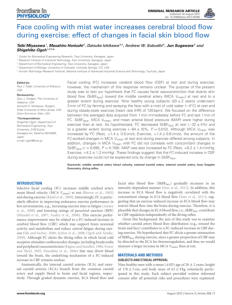





Authors: Jean-Eric Blatteau, Julien Hugon, Emmanuel
Gempp, Olivier Castagna, Christophe Peny,
Nicolas Vallee.
Preventive measures to reduce the risk of decompression
sickness can involve several procedures, such as oxygen-
breathing during in-water decompression.
Theoretical predictions also suggest that brief
recompression periods during decompression could be a
method for controlling bubble formation. This study
aimed to get more precise information about the effects
of different experimental ascent profiles (EAPs) on bubble
reduction, using pure oxygen or recompression during
decompression for nitrox diving.
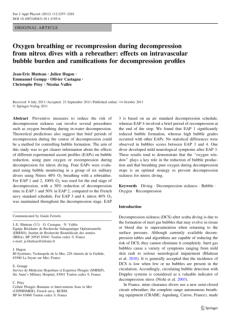

Authors: Marko Ljubkovic, Jaksa Zanchi, Toni Breskovic,
Jasna Marinovic, Mihajlo Lojpur, and Zeljko Dujic
Scuba diving leads to tissue gas supersaturation during
ascent and venous gas emboli (VGE) formation. VGE
crossover to systemic arteries (arterialization), mainly
through the patent foramen ovale, has been implicated in
various diving-related pathologies. Since recent research
has shown that arterializations frequently occur without
cardiac septal defects, this study aimed to investigate the
mechanisms responsible for these events.


Authors: R. Arieli & A Marmur
It is a long-standing hypothesis that the bubbles which
evolve as a result of decompression have their origin in
stable gas micronuclei. In a previous study (Arieli and
Marmur, 2011), the authors used hydrophilic and
monolayer-covered hydrophobic smooth silicon wafers to
show that nanobubbles formed on a flat hydrophobic
surface may be the gas micronuclei responsible for the
bubbles that evolve to cause decompression sickness. On
decompression, bubbles appeared only on the
hydrophobic wafers. The purpose of the present study
was to examine the dynamics of bubble evolution.
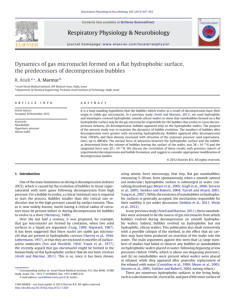

Authors: O. Hyldegaard, D. Kerem, Y. Melamed
Deep tissue isobaric counterdiffusion that may cause
unwanted bubble formation or transient bubble growth
has been referred to in theoretical models and
demonstrated by intravascular gas formation in animals,
when changing inert breathing gas from nitrogen to
helium after hyperbaric air breathing. The authors visually
followed the in vivo resolution of extravascular air bubbles
injected at 101 kPa into nitrogen supersaturated rat
tissues: adipose,spinal white matter, skeletal muscle or tail
tendon.
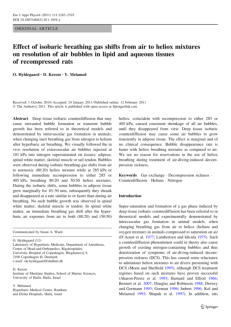

Authors:
Sema Yilmaz, Kenan Daglioglu, Dincer Yildizdas, Ibrahim
Bayram, Derya Gumurdulu, Sait Polat
Current treatment modalities and new therapeutic
approaches in acute repiratory distress syndrome primarily
focused on the resolution of alveolar edema. These
treatments include glucocorticoids, surfactants, inhaled
nitric oxide, antioxidants and various anti-inflammatory
treatments. Unfortunately, to date, none of these
pharmacologic treatments has proven to be effective. The
authors hypothesized that helium gas might have a
beneficial role in the treatment of ARDS.
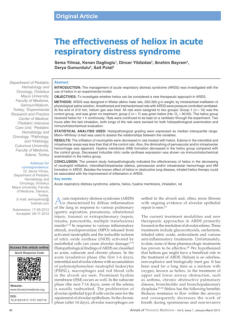

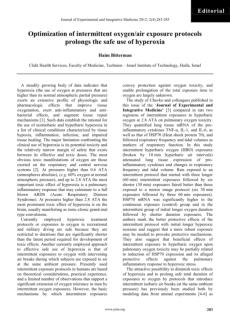

Authors:
Masaki Fujioka, Daisuke Niino, Masahiro Ito, and Yohjiro
Matsuoka
Patent Foramen ovale is a well know decease that affects
many divers and can lead to decompression accidents.
This document is the report of an autopsy that revealed a
patent foramen ovale of the heart that resulted in the
patient dying of paradoxical air embolization of the
coronary and cerebral arteries through a patent foramen
ovale because of right-to-left shunting.
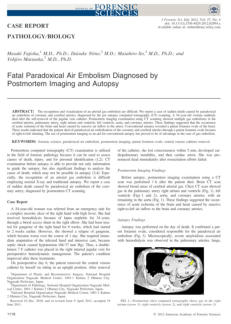

Authors: Barbara E. Shykoff & Dan E. Warkander
Combined effects on respiratory minute ventilation (VE )
and, thus, on end-tidal carbon dioxide partial pressure of
breathing resistance and elevated inspired carbon dioxide
had not been determined during heavy exercise. In this
Institutional Review Board-approved, dry, sea-level study,
12 subjects in each of three phases exercised to
exhaustion at 85% peak oxygen uptake while VE and P ET
CO2 were measured. Participants inhaled 0%, 1%, 2%, or
3% CO2 in air, or 0% or 2% CO2 in oxygen, with or
without breathing resistance, mimicking the U.S. Navy’s
MK 16 rebreather underwater breathing apparatus (UBA).
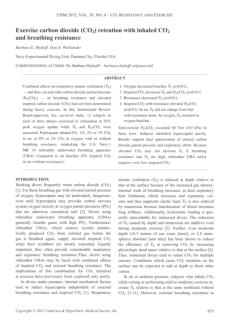


Authors:
A.C.P.K. Siriwardhana, R.G.N. Meegama, and G.M.L.P.
Aponsu
Sound waves propagate in all direction through air and
materials due to diffraction effect. Interference of sound
signals generated by several devices could create a noisy
state which is harmful for the human being at certain
instances in which noise intensity level is beyond 90 dB.
The system discussed in this research, facilitates to find
noise intensity levels at different places simultaneously and
further it identifies and point out the places where the
noisy state is harmful for human being. Corresponding
calculation by the system is mainly done based on the
direct source and reflection effects for the selected area.


Authors: J.C. Rostain, C. Lavoute, J.J. Risso, N. Vallee, M.
Weiss
Nitrogen narcosis occurs in humans at around 0.4 MPa (4
ATA). Hydrogen narcosis occurs between 2.6 and 3.0
MPa. In rats, nitrogen disturbances occur from 1 MPa and
a loss of righting reflex around 4 MPa.
Neurochemical studies in striatum of rats with nitrogen at
3 MPa with differential pulse voltammetry have
demonstrated a decrease in dopamine (DA) release by
neurons originated from the substantia nigra pars
compacta (SNc). Such a decrease is found also with
compressed argon, which is more narcotic than nitrogen
and with the anesthetic gas nitrous oxide. Inversely,
compressed helium with its very low narcotic potency
induces DA increase. Microdialysis studies in the striatum
have indicated that nitrogen also induces a decrease of
glutamate concentration. receptors activities in SNc.
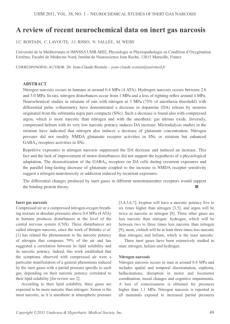

Authors: Paul Schaffer and Reginald F. Baugh
Acute otitis externa is a common condition involving
inflammation of the ear canal. The acute form is caused
primarily by bacterial infection, with Pseudomonas
aeruginosa and Staphylococcus aureus the most
common pathogens. Acute otitis externa presents with
the rapid onset ofear canal inflammation, resulting in
otalgia, itching, canal edema, canal erythema, and
otorrhea, and often occurs following swimming or minor
trauma from inappropriate cleaning. Tenderness with
movement of the tragus or pinna is a classic finding.
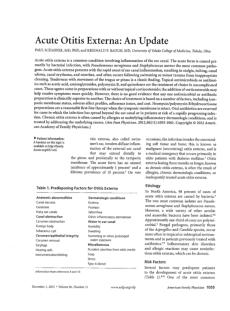

Authors: Christian R Gutvik, Tor Arne Johansen, Alf O
Brubakk
The objective of the work presented in this article is to
minimize the time spent decompressing.
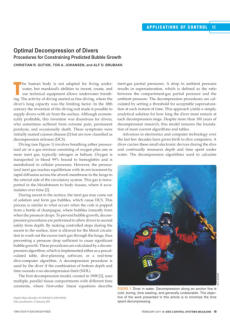

Authors: Jacek Kot
Clear differences between professional and recreational
deep diving are disappearing, at least when taking into
account the types of breathing mixtures (oxygen, nitrox,
heliox, and trimix) and range of dive parameters (depth
and time). Training of recreational deep divers is
conducted at depths of 120–150 metres and some divers
dive to 180–200 metres using the same diving
techniques. Extremely deep recreational divers go to
depths of more than 200 metres, at which depths the
physical and chemical properties of breathing gases
create some physiological restrictions already known from
professional deep diving.
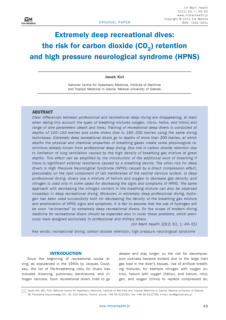

Authors:
Marc Dalecki, Otmar Bock, and Benjamin Schulze
Clear differences between professional and recreational
deep diving are disappearing, at least when taking into
account the types of breathing mixtures (oxygen, nitrox,
heliox, and trimix) and range of dive parameters (depth
and time). Training of recreational deep divers is
conducted at depths of 120–150 metres and some divers
dive to 180–200 metres using the same diving
techniques. Extremely deep recreational divers go to
depths of more than 200 metres, at which depths the
physical and chemical properties of breathing gases
create some physiological restrictions already known from
professional deep diving.
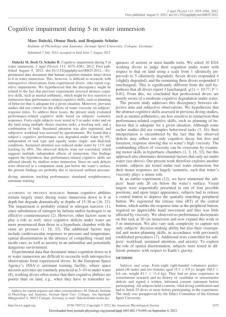

Authors:
Andreas Møllerløkken, Toni Breskovic, Ivan Palada, Zoran
Valic, Zeljko Dujic and Alf O Brubakk
The aim of this study was to compare the number of
venous gas bubbles observed following a short, deep,
and a shallow long air dive performed in a hyperbaric
chamber, and following actual dives in open water.
The authors conclude that diving in water produces
significantly more bubbles than dry diving.
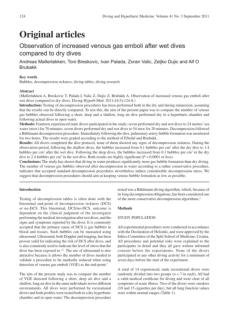

Authors:
Jean-Eric Blatteau, Emmanuel Gempp, Pascal Constantin
and Pierre Louger
This study was conducted to examine the influence of
short delays to recompression and other risk factors
associated with the development of severe neurological
decompression sickness in military divers.
Fifty-nine divers, treated for decompression sickness in less
than 6 hours, were included respectively. Diving
parameters, symptom latency, and recompression delay
were analyzed. Clinical symptoms were evaluated for
both the acute event and one month later.
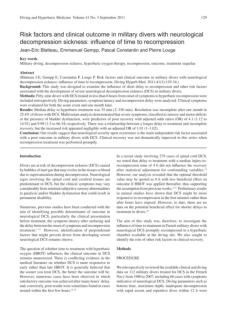

Authors: Austin Cope, Joan V Eggert and Erin O’Brien
This study describes a case series of 11 patients with
retinal artery occlusion treated with hyperbaric oxygen
therapy (HBOT) at Intermountain Dixie Regional Medical
Center between 2005 and 2009. the authors then
combined data from our case series with data from two
other case series to report a combined total of 51 patients.
Eight of 11 patients achieved improved visual acuity.
Analysis of the combined case series showed that 74% of
patients treated with HBOT had an improvement in visual
acuity, with 53% improving by two lines or more on a
modified Snellen valu
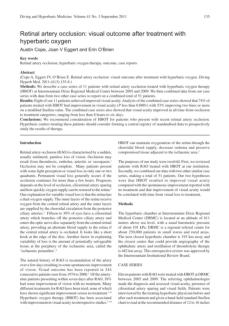

Authors: S Lesley Blogg and Mikael Gennser
Audio Doppler ultrasound and echocardiographic
techniques are useful tools for investigating the formation
of inert gas bubbles after hyperbaric exposure and can
help to assess the risk of decompression sickness
occurrence.
This review summarises comprehensive Doppler data
collected over 15 years across many dive profiles and then
assesses the effectiveness of measurements made
between 30 and 60 minutes (min) post-dive (commonly
measured time points made in recent studies) in
characterising the evolution and peak of venous gas
emboli (VGE).
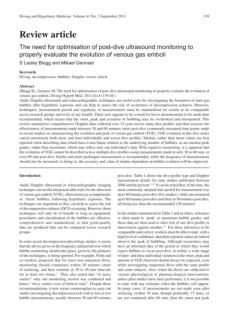

Authors: Si Jack Chong, Meng Kwan Tan, Weihao Liang,
Soo Joang Kim and Chai Rick Soh
Both negative pressure wound therapy (NPWT) and
hyperbaric oxygen therapy (HBOT) are useful modalities
in the treatment of problematic wounds. However, none
of the commercially available portable negative-pressure
devices has been certified safe for use in a recompression
chamber. Thus, the NPWT device is removed while the
patient undergoes HBOT. The purpose of this study is to
demonstrate that wound negative pressure can be
effectively and safely maintained during HBOT.


Authors: Christian Mehl, Frank Heblich, Rudolf Lenz, Klaus
Ludwig and Matthias Kern
The purpose of this in-vitro study was to determine
whether there is a correlation between a hyperbaric
environment increased oxygen partial pressure, and the
corrosion of dental alloys used for dental restorations in
divers.
Samples of three commercially available dental alloys were
tested in the DIN EN ISO 1562 static immersion test, and
the amount of dissolved ions was measured using atomic
absorption spectrometry.
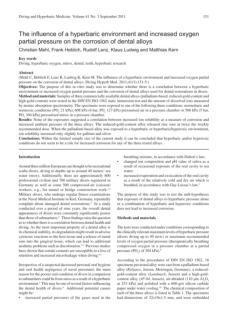

Authors: Denis A. Tolstun, Khachik K. Muradian, Vladislav
V. Bezrukov
Interest in hypercapnia and its practical applications has
significantly grown. An analysis of literary data shows a
wide range of systemic and local applications. Due to its
powerful effect on blood circulation, vascular elasticity,
activation of angiogenesis, and inhibition of pro-
inflammatory factors, hypercapnia is already used in
dermatology, phlebology, and therapy. Wide
opportunities open up for use in neurology, given the
powerful neuroprotective effect of carbon dioxide, which
not only increases tolerance to ischemia, preventing the
development of diseases, but can also become a tool for
the treatment of stroke and heart attack.
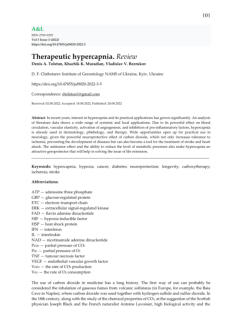

Authors: N.A.M. Schellart , & W. Sterk
Decompression tables indicate that a repetitive dive to the
same depth as the first dive should be shortened to obtain
the same probability of occurrence of decompression
sickness (pDCS). Repetition protocols are based on small
numbers, a reason for re-examination. Since venous gas
embolism (VGE) and pDCS are related, one would expect
a higher bubble grade (BG) of VGE after the repetitive
dive without reducing bottom time.


Authors: Ingrid Eftedal, Arve Jørgensen, Ragnhild
Røsbjørgen, Arnar Flatberg, and Alf O. Brubakk
The aim of this study was to analyze genetic reactions that
may be involved in acute changes in vascular function in
divers. Rats were exposed to 709 kPa of hyperbaric air
(149 kPa PO2 ) for 50 minutes, followed by post-dive
monitoring of vascular bubble formation and full genome
microarray analysis of the aorta from diving rats and
unexposed controls.


Click on the octopus
to return to the top
of the page



Authors: Christoph Klingmann, Nils Rathmann, Daniel
Hausmann, Thomas Bruckner and Rolf Kern
Divers with a history of decompression sickness (DCS)
who adopted more conservative diving profiles (CDP)
showed a significant reduction in the recurrence of DCS,
regardless of the presence or size of a right-to-left shunt.
This study involved 27 divers who, after experiencing DCS,
changed their diving practices upon recommendation.
They performed a total of 9,236 dives post-
recommendation with only four instances of DCS,
compared to 34 instances during 17,851 pre-
recommendation dives. This suggests that conservative
diving effectively lowers the risk of subsequent DCS.


Authors: Michael H Bennett, Simon J Mitchell, Derelle
Young and David King
In August 2011, the South Pacific Underwater Medicine
Society and the Hyperbaric Technicians and Nurses
Association held a one-day workshop to discuss the use of
deep recompression treatment tables for decompression
illness in Australia and New Zealand. The goal was to
create consensus statements to guide regional practices,
focusing on 405 kPa (30 msw) depth tables with helium-
oxygen mixes, covering indications, staffing, and technical
requirements. This report summarizes the evidence and
consensus statements from the workshop.
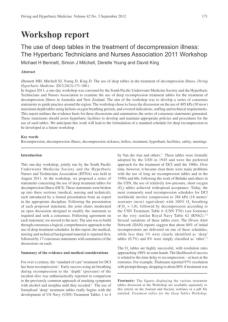

Authors: Mayuree Sampanthavivat, Wararat Singkhwa,
Thanasawat Chaiyakul, Sangdaw
Karoonyawanich and Haruthai Ajpru
This study evaluated the effectiveness of hyperbaric
oxygen therapy (HBOT) on 60 Thai children with autism
aged three to nine years. Participants underwent 20 one-
hour sessions of either HBOT at 153 kPa or sham air at
116 kPa. The results indicated significant behavioral
improvements in both groups, but no significant
differences were found between the HBOT and sham
groups. Overall, no definitive clinical benefit from HBOT
was observed, although both treatments were safe and
well-tolerated.
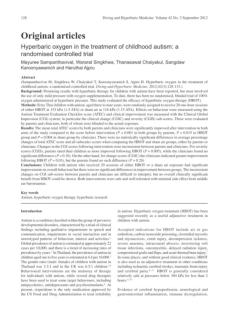

Authors: Nada Bilopavlovic, Jasna Marinovic, Marko
Ljubkovic, Ante Obad , Jaksa Zanchi, Neal W.
Pollock, Petar Denoble, Zeljko Dujic
The study investigated changes in markers of endothelial
and brain damage after repetitive SCUBA diving, while
also assessing venous gas bubble production and
arterialization. Despite significant bubble production and
occasional arterialization, no changes were observed in
the levels of endothelin-1 and neuron-specific enolase.
However, the levels of the S100 calcium-binding protein B
(S100B) were significantly elevated after the 18-meter and
control dives, suggesting its release from skeletal muscles
rather than indicating brain or endothelial damage.


Authors: S.K. Hooker et al.
The study reviews the evidence of gas bubbles in the
tissues of marine mammals and discusses theories of gas
loading and bubble formation. It suggests that diving
mammals adjust their physiological responses to various
stressors and proposes a shift in focus from minimizing to
managing N2 load. This opens up multiple research
avenues, from studying the effects of gas bubbles at
various biological levels to examining their relationship
with diving behavior. Technological advancements in
imaging and remote instrumentation are expected to
further enhance this field of study. .
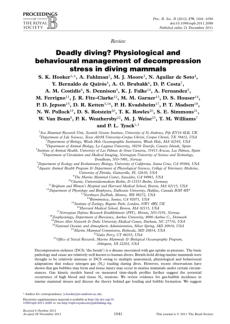



Authors: I. A. Brownlee, A. C.Fairclough, A. C. Hall, and J.
R. Paxman
This study intends to provide a comprehensive review of
the current evidence regarding the consumption of
seaweed and seaweed isolates, their potential health
benefits, and their applications in food products. Gaps in
current knowledge and suggested future research
strategies to maximize the potential uses of seaweed in
food products are also highlighted.


Authors: R. Arieli, A. Marmur
This document presents and supports a scientific
hypothesis regarding the origin of bubbles that cause
decompression sickness. The authors propose that
nanobubbles forming on hydrophobic surfaces
submerged in water may serve as gas micronuclei
responsible for bubble evolution during decompression.
To support their hypothesis, they describe an experiment
involving hydrophilic and hydrophobic silicon wafers,
showing that bubbles evolved only on hydrophobic
surfaces after decompression.
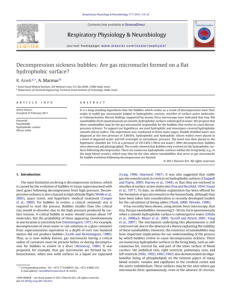

Authors: Pierre-Emmanuel Rautou, Anne-Clemence Vion,
Nicolas Amabile, Gilles Chironi, Alain Simon, Alain
Tedgui, Chantal M. Boulanger
This document explains the role and impact of
membrane-shed submicron microparticles (MPs) in the
context of atherothrombotic diseases and atherosclerosis.
That includes the origin and release of MPs during cell
activation or apoptosis, the potential of MPs as biomarkers
for vascular injury and predictors of cardiovascular events,
the accumulation and effects of MPs in atherosclerotic
lesions, and the mechanisms by which MPs contribute to
the development, progression, and complications of
atherosclerosis.
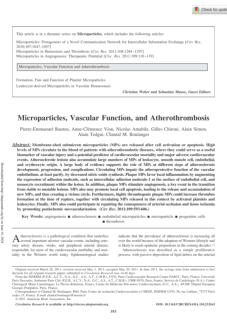

Authors: Jian-Guo Wang, Julie C. Williams, Beckley K.
Davis, Ken Jacobson, Claire M. Doerschuk, Jenny
P.-Y. Ting, & Nigel Mackman
This document presents scientific research findings on
how monocytic microparticles (MPs) activate endothelial
cells, particularly in the context of inflammation and
disease. The study investigates the mechanisms by which
MPs from lipopolysaccharide (LPS)-treated monocytic cells
induce endothelial cell activation, highlighting the role of
IL-1 Beta and inflammasome components in this process.
The research aims to elucidate the pathways involved and
the potential implications for inflammatory diseases.
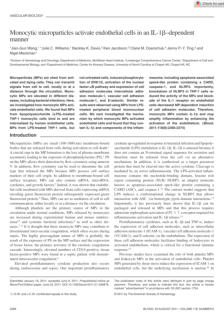

Authors:
Anni Vanhatalo, Jonathan Fulford , Stephen J. Bailey,
James R. Blackwell, Paul G. Winyard, & Andrew M. Jones
This text conveys the findings of a study that demonstrates
the benefits of dietary nitrate supplementation in
improving muscle efficiency and exercise tolerance under
conditions of reduced oxygen availability (hypoxia). It aims
to inform readers that nitrate can be converted in the
body to nitrite and nitric oxide, which help reduce muscle
fatigue and enhance oxygen delivery to muscles. It
suggests potential applications of dietary nitrate for
improving exercise performance at high altitudes and in
medical conditions that impair oxygen delivery to muscles.
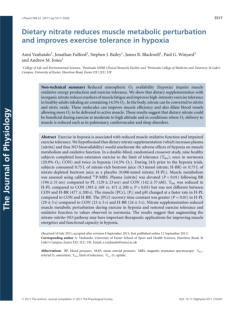

Authors:
Ming Yang, Tatyana N. Milovanova, Marina Bogush,
Günalp Uzun, Veena M. Bhopale, and Stephen R. Thom
This study investigates how decompression stress leads to
an increase in the number and size of annexin V-coated
microparticles derived from various cell types. The
research explores the hypothesis that these changes are
due to inert gas bubbles and can be mitigated by
hydrostatic pressure. The study further examines the
proinflammatory potential of these particles and their role
in vascular damage, demonstrating that particles from
decompressed mice cause significant inflammatory and
vascular changes when injected into mice.


Authors: Marianne B. Havnes, Catrine Ahlen, Alf O.
Brubakk, and Ole-Jan Iversen.
This document discusses the findings of a scientific study
that investigated the production of autoantibodies against
Heat Shock Protein 60 (HSP60) in rats immunized with
Pseudomonas aeruginosa and the influence of diving on
the levels of these autoantibodies. The study aims to
understand the relationship between P. aeruginosa
infections, common in saturation divers and cystic fibrosis
patients, and the immune response involving HSP60. The
results indicate that immunization with P. aeruginosa
increases autoantibodies against HSP60, but this increase
is not observed in rats that were both immunized and
subjected to simulated diving conditions.
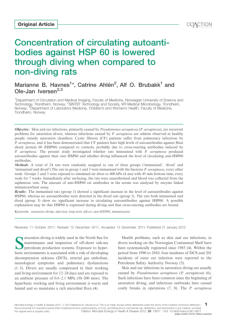

Authors:
Lisette B. Soegaard, Marie N. Hansen, Cornelis van Elk,
Jesper Brahm, and Frank B. Jensen.
The study of sea mammals is a path to better
understanding physiological phenomena linked to diving.
This document explains a scientific investigation into the
physiological traits of harbor porpoises that are adaptive
for their diving behavior. The study focuses on various
aspects such as blood oxygen-transporting properties,
buffer characteristics, chloride transport via the erythrocyte
anion exchanger (AE1), circulating nitric oxide
metabolites, and hemoglobin nitrite reduction.
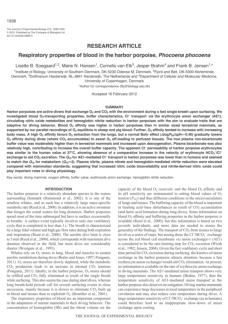

Authors:
Helene N. David, Benoıt Haelewyn, Mickael Degoulet,
Denis G. Colomb, , Jean-Jacques Risso, Jacques H. Abraini
Argon is known for its high Narcosis properties and is not
used in diving breathing mixes for these reasons.
However, it can have other applications. This study
investigates whether this gas can provide neuroprotection
after excitotoxic or ischemic events. The results indicate
that while argon has beneficial effects at the cortical level,
it may increase subcortical brain damage if administered
post-ischemia. The authors suggest that argon should be
administered during ischemia, before reperfusion, to
maximize its neuroprotective benefits and minimize
potential harm.
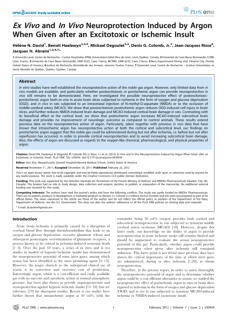

Authors:
Sara R. Zwart, J. Milburn Jessup, Jiuping Ji, Scott M. Smith
This study investigated the effects of an oxygen-rich
environment on oxidative damage, iron stores, and
vitamin status, particularly folate, in humans. It involved
participants undergoing a saturation dive in a hyperoxic
environment, and it aimed to assess the biochemical
markers of iron status, oxidative damage, and vitamin
status before, during, and after the dive. The results
indicated that increased body iron stores and oxidative
stress were associated with decreased folate status and an
elevated DNA damage repair response. The study
suggests that folate requirements may be higher in such
environments.
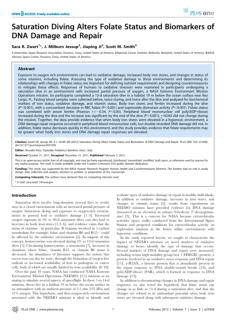

Authors:
Stephen R. Thom, Tatyana N. Milovanova, Marina Bogush,
Veena M. Bhopale, Ming Yang, Kim Bushmann, Neal W.
Pollock, Marko Ljubkovic, Petar Denoble, and Zeljko Dujic
This study evaluated the presence of annexin V-positive
microparticles (MPs) and neutrophil activation in humans
following decompression from open-water SCUBA diving.
It was hypothesized that these changes are related to
intravascular bubble formation. The document details the
methodology, including the profile of the dives, the timing
of blood sample collection, and the techniques used to
quantify intravascular bubbles and assess neutrophil
activation. It also summarizes the key findings, such as the
increase in MPs, neutrophil activation, and the interactions
between platelets and neutrophils.
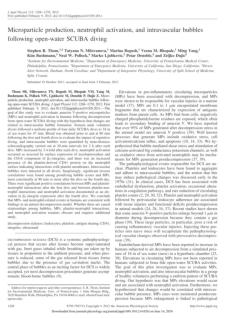

Authors:
Ivan. T. Demchenko, Alexander N. Moskvin, Alexander I.
Krivchenko, Claude A. Piantadosi, & Barry W. Allen
This study evaluated the presence of annexin V-positive
microparticles (MPs) and neutrophil activation in humans
following decompression from open-water SCUBA diving.
It was hypothesized that these changes are related to
intravascular bubble formation. The document details the
methodology, including the profile of the dives, the timing
of blood sample collection, and the techniques used to
quantify intravascular bubbles and assess neutrophil
activation. It also summarizes the key findings, such as the
increase in MPs, neutrophil activation, and the interactions
between platelets and neutrophil.
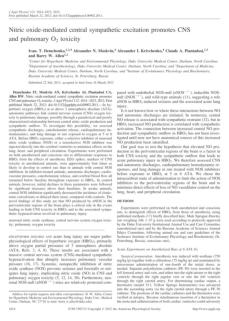

Authors: Sermin Sengun, Atilla Uslu, Salih Aydin
This study investigates the level and source of dehydration
in divers who use heliox. Using multifrequency
bioelectrical impedance analysis (MF-BIA), it aims to
determine whether the dehydration is intracellular,
extracellular, or both. The text outlines the study's
background, objective, methodology, results, and
conclusions.
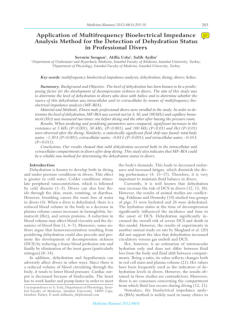

Authors: Assim A. Alfadda, and Reem M. Sallam
This document provides an overview and summary of the
roles of reactive oxygen species (ROS) in health and
disease. It aims to highlight the biological effects of ROS,
their production, and metabolism in cellular organelles
like the endoplasmic reticulum and mitochondria, as well
as recent research findings that have advanced the
understanding of ROS in redox regulation. It also offers a
brief perspective on research to enhance the knowledge
of ROS actions in various health and disease conditions.

Authors:
Yara Bernaldo de Quirós, Oscar González-Diaz, Manuel
Arbelo, Eva Sierra, Simona Sacchini, Antonio Fernández
As previously mentioned, studies on sea mammals help to
understand phenomena linked to diving. This document
presents the findings from a survey of gas embolic lesions
in stranded cetaceans, particularly in relation to military
sonar. It aims to analyze the prevalence, amount,
distribution, and composition of gas bubbles in marine
mammal tissues, taking into account species-specific
variability and the impact of decomposition. It also
provides recommendations for necropsy procedures to
minimize the masking effects of putrefaction gases and
highlights the significance of gas bubble amounts in
pathological assessments.
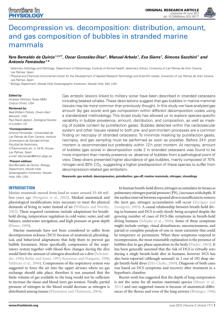
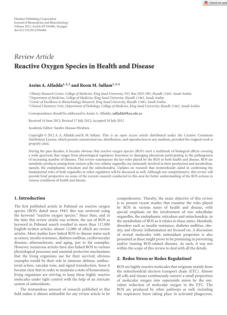

Authors:
Manav V Vyas, Amit X Garg, Arthur V Iansavichus, John
Costella, Allan Donner, Lars E Laugsand, Imre Janszky,
Marko Mrkobrada, Grace Parraga, Daniel G Hackam
This study is a systematic review and meta-analysis of
observational studies to determine the association
between shift work and major vascular events, such as
myocardial infarction, ischemic stroke, and coronary
events. It outlines the methodology used for data
collection and analysis, the results of the studies reviewed,
and the implications of these findings for public policy and
occupational medicine.
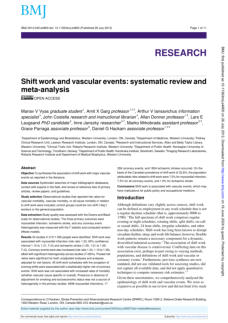

Authors:
Mikulas Chavko, Usmah Kawoos, Saleena Adeeb, Jason
Lankasky, Charles R. Auker, Richard M. McCarron
The authors of this study investigate the protective effects
of intermittent hyperbaric oxygen (HBO2) exposure
against the central nervous system (CNS) and pulmonary
toxicity. The study aims to optimize the duration of HBO2
cycles to enhance protective outcomes. It describes the
methods used, including the exposure of rats to different
HBO2 cycles and the assessment of lung inflammation
and respiratory changes. The results indicate that
intermittent HBO2 exposure is more effective in reducing
lung inflammation and respiratory changes compared to
continuous exposure.
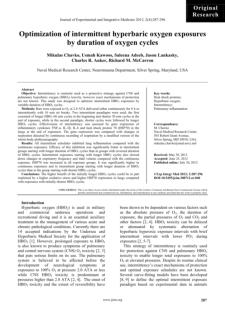

Authors: Christopher J. Morris; Jessica N. Yang; and Frank
A. J. L. Scheer
This paper intends to convey scientific findings regarding
the relationship between the circadian timing system, shift
work, and the increased risk of cardiovascular and
metabolic diseases. The research explains how the body's
internal clock influences cardiovascular risk markers and
how misalignment between the circadian rhythm and
external factors, such as shift work, can lead to adverse
health outcomes.
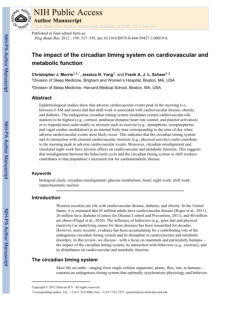

Authors: Earl S Ford, & Carl J Caspersen
This study summarizes research on the relationship
between sedentary behavior, specifically screen time and
sitting time, and the risk of cardiovascular disease (CVD).
Based on prospective studies that primarily used self-
reported data, it highlights the association between
increased sedentary time and higher risks of both fatal and
non-fatal CVD. Additionally, it suggests that future
research using more objective measures of sedentary
behavior could provide more accurate risk assessments
and inform public health guidelines and interventions to
reduce sedentary behavior.
